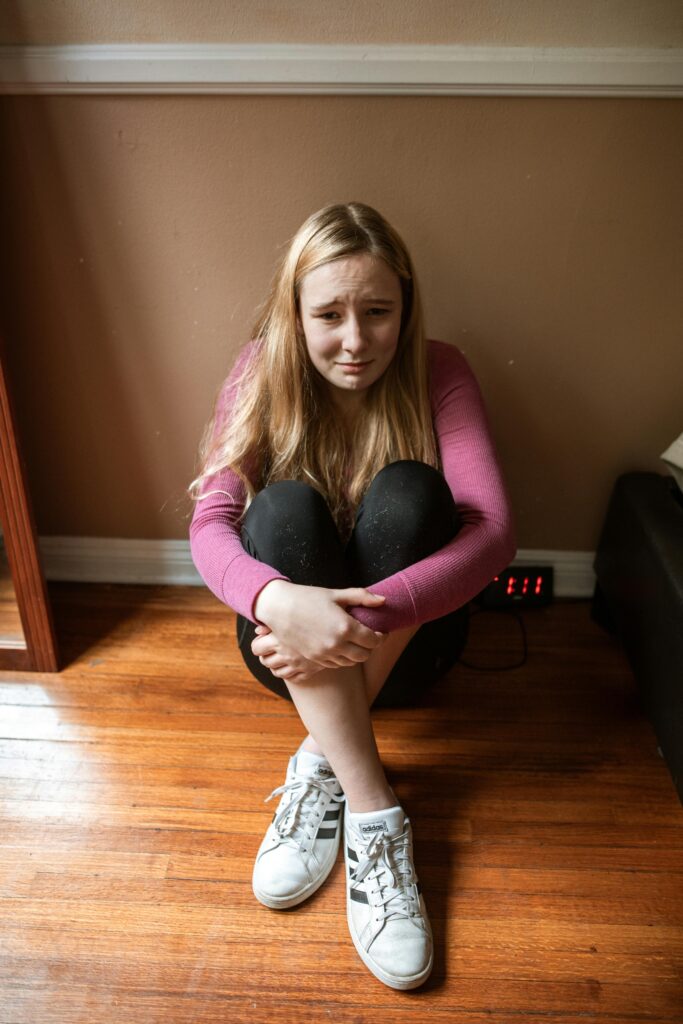ADHD Masking in Girls: Understanding the Hidden Struggle
by Alison Potter, MSW, LICSW
As parents, we want to recognize when our children are struggling. But what happens when that struggle is invisible? For many girls with ADHD, their challenges remain hidden behind a carefully constructed mask of “normalcy.” Understanding ADHD masking in girls is crucial for parents who want to support their daughters’ authentic development and well-being.
There is evidence that there is a gender gap in diagnosing childhood ADHD due to masking, broad diagnostic criteria, level of coping abilities, and differences in expression of symptoms. The Diagnostic and Statistical Manual of Mental Disorders, Fifth Edition, (DSM-5) is the gold standard for diagnosing in the medical and mental health professions. Traditionally, the DSM criteria for diagnosing ADHD has followed research on males who demonstrate more hyperactive traits. Girls with ADHD mostly express inattentive tendencies and often implement better coping skills that are “socially appropriate.” Therefore, they are often missed in childhood leaving parents and girls feeling isolated and lost until they hopefully are diagnosed in childhood.
Research indicates the percentage of women diagnosed with ADHD as adults nearly doubled from 2020-2022.
What is ADHD Masking?
ADHD masking, also called “camouflaging,” occurs when individuals suppress or hide their ADHD symptoms to fit social expectations. For girls, this often means appearing quiet, compliant, and academically successful while internally struggling with attention, organization, social interactions, and emotional regulation.

Unlike the stereotypical image of ADHD as hyperactive boys disrupting classrooms, girls with ADHD often present differently. They may be the daydreamers staring out the window, the girls who talk “too much”, the perfectionists staying up late to complete assignments, or the people-pleasers who never cause trouble. Their symptoms are internalized rather than externalized, making them nearly invisible to parents, teachers, and even healthcare providers.
Why Girls Mask More Than Boys
Several factors contribute to higher rates of masking among girls with ADHD:
Social Expectations: From an early age, girls receive messages about being “good,” quiet, polite, and accommodating. These societal pressures encourage girls to suppress behaviors that might be seen as disruptive or inappropriate. Choosing to behave as society expects can mean the difference between having friends or being isolated and bullied.
Different Symptom Presentation: Girls are more likely to have the inattentive type of ADHD, which lacks the obvious hyperactive behaviors that typically prompt evaluation and diagnosis.
Higher Social Awareness: Research suggests that girls often develop stronger social awareness earlier than boys, making them more conscious of how their behavior affects others and more motivated to conform.
Fear of Rejection: Girls with ADHD often develop an intense fear of social rejection, leading them to work overtime to appear “normal” and maintain relationships.
The Social Impact of Masking
Masking takes a tremendous toll on girls’ social development and relationships. Girls with ADHD often feel “different” than their peers and can never truly be themselves without judgment or harsh criticism. Some of these social impacts of masking include:
Exhausting Social Interactions: Constantly monitoring and adjusting behavior in school and social situations is mentally and emotionally draining. Girls may come home from school completely depleted from the effort of appearing “normal” all day.
Difficulty Forming Authentic Relationships: When a young girl is constantly masking, it becomes challenging to form genuine connections with others. Many girls report feeling like their friends don’t really know the “real” them.
Social Anxiety: The pressure to maintain their mask can lead to significant social anxiety, particularly as girls enter adolescence when social dynamics become more complex.
Isolation: Some girls withdraw from social situations entirely to avoid the exhaustion of masking, leading to loneliness and isolation.
Educational Consequences
In educational settings, masking can create a perfect storm of unrecognized struggles. Too often, teachers miss girls with ADHD because of masking. These girls are often labeled by teachers as shy, lazy, not working to their full potential, and socially awkward:
Missed Diagnoses: Teachers may overlook girls who appear to be coping well academically, even when they’re working twice as hard as their peers to maintain their grades.
Inconsistent Performance: Girls may excel in some areas while struggling silently in others. Their successes can overshadow their difficulties, delaying needed support.
Perfectionism and Burnout: Many masked girls become perfectionists, spending excessive time on assignments and experiencing severe anxiety about making mistakes. This often leads to academic burnout by high school or college.
Inappropriate Classroom Behavior: Some girls become so dysregulated at school from internalizing and masking they display “socially inappropriate” behaviors such as inflexible thinking, difficulty with transitions, crying, whining, defiance, interrupting, talking too much, annoying classmates, and having a messy work area. These can also be considered symptoms of ADHD.
Missed Learning Accommodations: Without a diagnosis and subsequent IEP or 504 plan evaluation, girls miss out on accommodations that could significantly improve their educational experience and reduce their stress.
Emotional and Mental Health Impact
While masking may help girls navigate social situations and academic expectations in the short term, it comes at a profound psychological cost. The constant effort to suppress natural behaviors and present a “normal” facade creates a cascade of mental health challenges that can persist long after the initial need to mask has passed. Many girls find themselves trapped in a cycle where the very strategies they use to cope actually worsen their overall wellbeing.
The emotional cost of masking cannot be overstated:
Identity Confusion: When you spend years hiding your authentic self, it becomes difficult to know who you really are. Many girls struggle with identity issues and feel like they’re living a lie.
Depression and Anxiety: The constant effort required for masking, combined with feeling misunderstood and different, often leads to depression and anxiety disorders.
Low Self-Esteem: Despite appearing successful to others, many masked girls have profoundly low self-esteem. They may believe they’re fundamentally flawed or broken. They too often feel like a failure and disappointment.

Emotional Dysregulation: Suppressing ADHD symptoms doesn’t make them disappear. The effort often leads to emotional explosions at home, where girls finally feel safe to let their guard down.
Increased Risk of Eating Disorders: Research shows that girls with ADHD have higher rates of eating disorders, possibly as another form of control when everything else feels chaotic.
Co-Occurring Disorders: Girls with ADHD often have co-occurring (co-morbid) diagnoses such as anxiety, depression, OCD, mood and tic disorders, sleep disorders, disordered eating, oppositional defiance disorder (ODD), or conduct disorder (CD). According to research on comorbidities in ADHD, girls and women with ADHD reportedly have 50.4% more anxiety than boys and men.
Recognizing the Signs of Masking
Recognizing signs of ADHD symptom masking is the first step toward getting your daughter evaluated and diagnosed, which will set her on the best path for receiving appropriate guidance and accommodations. Taking these steps can bring significant relief to both you and your daughter
As parents, watch for these potential indicators:
- Your daughter appears “perfect” at school but has meltdowns at home
- Teachers never send home reports on “inappropriate” behavior, but you see something different at home
- She spends excessive time on homework that should take much less time
- She’s extremely hard on herself about mistakes
- She seems to have friends but doesn’t feel truly understood by them
- She continually reports being bullied or left out at school
- She’s exhausted after social situations
- She avoids trying new things due to fear of failure
- She has difficulty with organization despite appearing put-together
- She experiences anxiety around academic or social performance
- She is fidgety and constantly moving
Supporting Your Daughter
If you suspect your daughter may be masking ADHD symptoms:
Seek Professional Evaluation: Find a healthcare provider experienced in diagnosing ADHD in girls. Many traditional assessments miss girls because they’re designed around male presentations of ADHD and DSM criteria. With increased awareness around this topic, it’s important to do your research and find someone who not only has experience but also is an advocate for your child.
Create a Safe Home Environment: Make your home a place where your daughter can unmask safely. Let her know that her authentic self is welcomed and valued.
Validate Her Experiences: Acknowledge that her struggles are real, even if they’re not immediately visible to others. Avoid phrases like “but you’re doing so well” that might encourage continued masking. Bringing her struggles and feelings into the light is half the battle!
Advocate at School: Work with teachers and school counselors to ensure your daughter receives appropriate support, even if her struggles aren’t immediately apparent. This is where finding a healthcare provider who will advocate for your daughter will benefit your child. Traditional evaluations require teacher reports which most often come back with glowing feedback and no observations of traditional ADHD. Don’t allow this to stop you!
Model Authenticity: Show your daughter that it’s okay to be imperfect and to ask for help when needed.
Consider Therapy: A therapist experienced in ADHD and girls can help your daughter develop healthy coping strategies and work through the emotional impact of masking.
The Path Forward
Understanding ADHD masking in girls is the first step toward creating a world where our daughters can be authentically themselves. When we recognize and address masking, we give girls the opportunity to develop genuine self-awareness, build authentic relationships, and achieve success without sacrificing their mental health.
Remember, the goal isn’t to eliminate all coping strategies—some level of social adaptation is normal and healthy. The goal is to help our daughters find a balance where they can navigate social expectations without losing themselves in the process.
Your daughter’s ADHD brain brings unique strengths: creativity, empathy, intuition, and the ability to see the world differently. When we help her unmask safely and support her authentic self, we allow these strengths to flourish while addressing the very real challenges she faces.

As parents, our role is to be detectives, advocates, and safe harbors. By understanding masking, we can better support our daughters in developing into confident, authentic young women who know their worth isn’t determined by their ability to hide who they are.
If you suspect your daughter may be masking ADHD symptoms, trust your instincts and seek professional guidance. Early recognition and support can make a profound difference in her long-term well-being and success.
September 26, 2025
the Blog
Mailing List
Join the list and get access to the Parenting Specialist bimonthly newsletter filled with parenting advice, lessons, and stories to inspire!
Alison Potter is a parent education consultant and consultant to therapists, based in Washington State.
hello@theparentingspecialist.com
425-537-7078
Follow Us
SHOP